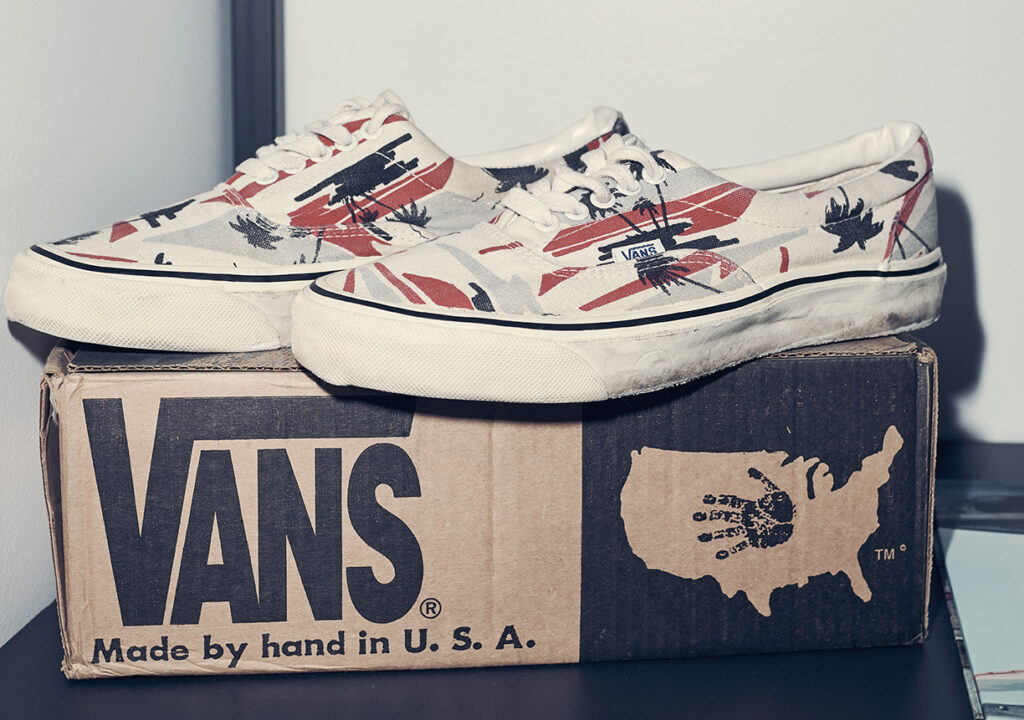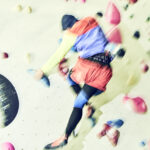Vans is legendary. Their slogan, “Off the Wall,” encapsulates the notion of throwing fear to the wind and honoring spirit, individuality and bravery. Vans lionizes the act of being oneself unforgivingly, unrelentingly and with confidence. And in doing so, the company flourishes both symbolically and in market stature. Vans still dominates the scene of sports-oriented design, alongside brands like Converse and Nike. To wear a pair of classic Vans is to wordlessly tap into some ineffable and recognizable realm of coolness. Despite their long-standing and immense popularity, they’ve remained cool. The sneakers are worn by the gamut of humanity; by toddlers, by teenagers, by athletes, by celebrities, by elders, by those in the know and by those who dress for comfort. Owned by VF Corporation in Costa Mesa, California, Vans has been doing its thing well and unwaveringly since 1944.
The founder of the house, Paul Van Doren, dropped out of the eighth grade because he didn’t have a taste for school. His mother insisted that he work so he got a job at Randy’s, a pre-existing shoe manufacturer, sweeping the floors and working his way to become, at thirty four, Executive Vice President. He turned the company around, brought it to a point of success and eventually decided that it was time, with his brother, to start his own shoe brand.
The doors to the first Vans store opened in Anaheim, California in 1966. On opening day, twelve customers purchased Vans deck shoes now lovingly known to be “The Authentic” at a price point ranging from $2.49 to $4.99. The twelve sneaker sales cleaned out their entire inventory. Known still to be primarily a skate company, Vans has several indoor-outdoor skate parks, replete with areas for amateur skaters to practice ramps, skate plazas and bowls, street courses and in California even an arcade. Vans also sponsors surfing, BMX, snowboarding and motocross teams and events. The company immerses itself with cultural provinces beyond those of sports and design they throw weekly house parties hosted by bands ranging from Against Me! To Wolf Parade at their Chicago and Brooklyn houses of Vans. They’ve long tag teamed with other creatives to collaborate on limited edition pieces for which the demand is high; movies and TV shows (like The Simpsons and Spiderman), musicians (from sneakers with Ice-T to The Beatles Yellow Submarine Collection), other cult skate brands including Spitfire and Supreme, fashion designers like Raf Simons and Marc Jacobs, artists like Takashi Murakami and even, charmingly, Hello Kitty. And though their extensive reach is, in humble words, far-ranging and impressive, the house’s core aesthetic and values remain pure.
We caught a moment with Rian Eugene Pozzebon, the Global Footwear Design Director for Vans, who when not at the drawing board is raising two teenagers and “loving his German wife.” Rian was born in Pasadena, California, just south of Los Angeles and raised nearby in the San Gabriel Valley. There he doodled, rode a bike, then rode a skateboard, worked on short films, skated more, traveled, followed in the footsteps of the Vans founder and bailed on college, started a backpack company and managed and sold shoes at Stussy. It was then in 2002 that Rian, alongside his close friend Jon Warren, knew he wanted to chase something bigger. Namely, to design shoes and “rebuild the skate program” at Vans. He and his friends became disenchanted with the aesthetics of skater style as it became popular. They refused to be or look like anything but their authentic selves, in a river of skate culture that was quickly filling with goldfish. The market was then saturated with what Pozzebon refers to as “puffy skate shoes” and they wanted to reintroduce a more refined, 1990’s aesthetic to the skate market; to return to the classic streamlined Vans designs, to wear Vans and in doing so, stand out from their peers with grace. A bold move. Fear, Ryan admits with humility, has played a roll in his life on and off. At a young age he learned from its ways, “embraced it and battled it,” both on a skateboard and behind the wheel of a car. He firmly believes in the difficult (but worthy) cruciality of accepting the fact that the future is something that we can only control to a certain extent. He faces fear by accepting the unknown and “diving in head first.” For Pozzebon, doing so is more difficult in social situations than in a work context: “[Being] surrounded by people I don’t know, it breaks me. Fear hinders my opportunity to meet people. On top of a skateboard, I’ll charge it, as overcoming fear releases some overwhelming levels of thrill.”
He sees the notion of a “Comfort Zone” as a delicate “dancing between chaos and control” and notes that he’s been known to “generate or loiter in uncomfortable situations unknowingly.” For Pozzebon, dancing in public is dancing outside of his comfort zone. “I’ll dance all day alone,” he tells us. “And [I would never try] roller-blading at the beach. It looks far too uncomfortable” adding that he wishes that he had “the guts” to try his hand at making contemporary art.
Despite Vans’ (and Pozzebon’s) deep roots and tight ties in Southern California and in spite of Los Angeles’ distinctive potency, Rian has little to say about the city. When asked about what LA means symbolically, historically, emotionally or otherwise to him, Rian simply answered “Cars. Specifically the offensive amount of cars.”
Vans, like a few other rare specimens and labels, are marketed towards and for the fearless, or at least towards the facets of fearlessness that exist within each of us. They speak for knowing, being, loving and celebrating one’s self. If that isn’t true coolness, authenticity and bravery epitomized we don’t know what on this earth is.











